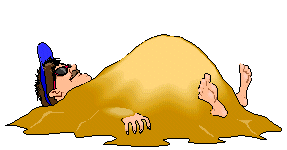Half Moon
Bay, Monterey, and Montara are similar because they have pieces of
quartz, feldspar (pink, orange, or white) and small black minerals in
them.
BODEGA, Sonoma County, California - .25-5mm; poorly sorted;
subrounded to angular. Contains chert, basalt, serpentinite, quartz,
feldspar, and greywacke. Along the Sonoma coast, you can see the high
energy waves eroding the rocks along the coast. The common rocks in this
general area are basalt, serpentinite, chert, and greywacke. The quartz
and feldspar are eroding from the chert or the greywacke.
CLEONE, Mendocino County, California -.25-0.5mm; well sorted;
subangular - subrounded. Contains quartz, feldspar, and dark lithic
fragments. The dark color is due to about 20% of lithic fragments. Also
may contain pieces of shell material. Type of rock from drainage area is
greywacke.
HALF MOON BAY, California - 0.1 - .25 mm; very well sorted,
subangular to subrounded. Contains quartz, feldspar, mica and minor
magnetite. The cliffs along Half Moon Bay reveals the Mother Rock for
this sand. The cliffs releases millions of sand grains to re-enter the
rock cycle.
MONTARA BEACH, California - 0.1 - 7mm; very poorly sorted;
subrounded. Contains quartz, feldspar, and small pieces of granite with
mica and hornblende. This sand is eroded directly from granitic rock
very close to the beach. This is near the famous "Devils
Slide" area, where very badly weathered granite has created very
spectacular cliffs.
MONTEREY, California - 025 -7mm; very poorly sorted; subangular.
Contains quartz, feldspar and pieces of granitic  rock. The Mother rock
is a granite, but unlike Montara Beach sand, Monterey has not been
chemically weathered. Abrasion of large boulders of granite along the
coast have mechanically broken this sand.
rock. The Mother rock
is a granite, but unlike Montara Beach sand, Monterey has not been
chemically weathered. Abrasion of large boulders of granite along the
coast have mechanically broken this sand.
RODEO BEACH, Marin County, California -0.1 -7mm; poorly sorted;
angular - rounded. Contains chert, serpentinite, quartz, basalt,
magnetite. This beach is in a cove behind the Golden Gate Bridge, where
very high energy waves erode the rocks exposed along this coast. The
source rocks include chert, serpentinite, and basalt.